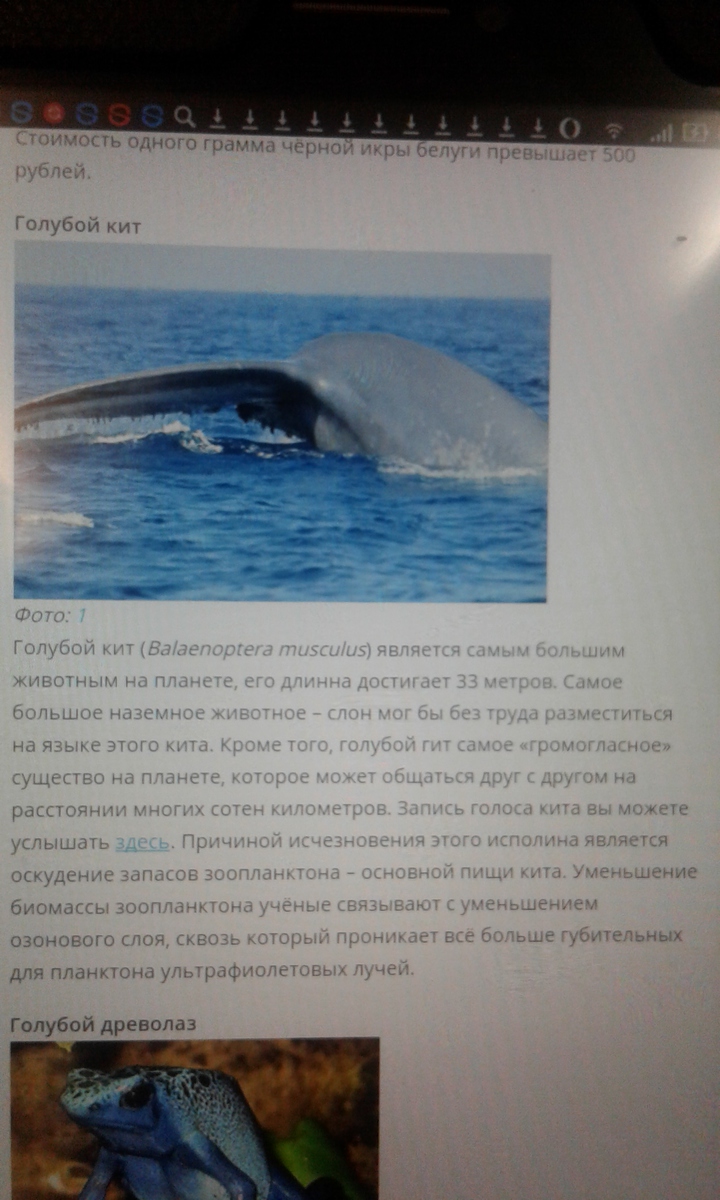Предмет: Другие предметы,
автор: Анжелика15л
ПЕРЕВЕДИТЕ ПОЖАЛУЙСТА НА АНГЛИЙЙСКИЙ ПРО КИТА!
Приложения:

Ответы
Автор ответа:
0
a marine animal of the order Cetacea belonging to the baleen whales (whale). The largest whale, the largest animal modern and probably the largest of all animals that ever lived on Earth. Its length is 33 meters, and weight can greatly exceed 150 tons[2][3].
The blue whale is a typical representative of baleen whales, feeding on plankton. He has a well developed filter apparatus formed by the plates of baleen. The blue whale feeds mainly on krill, rarely larger
crustaceans, small fish and cephalopods.
There are three subspecies of blue whale — Northern, southern and dwarf, slightly different in size and physique. Is the fourth subspecies — the Indian blue whale. The first two subspecies tend to krugoobraznymi cold water, and the third is found mainly in tropical seas. Lifestyle all subspecies are practically identical. Whales hold mostly alone, rarely in small groups, even in groups, they float separately. The historical habitat of the blue whale was the whole world ocean, but is currently badly broken. Compared to the lifestyle of many other cetaceans lifestyle of a blue whale is insufficiently studied[4].
Relative life expectancy of a blue whale there are various estimates, this issue has not been fully elucidated[5], but in any case, it is large — according to different sources, 80[6] or 80-90 years, with the oldest known specimens have an age of 110 years[7]. According to some scientists, these figures need to be verified, but in any case, well-researched herds of a blue whale (in the Gulf of St. Lawrence) the life of whales is not less than 40 years[8]. The longevity of blue whales is emphasized, for example, the fact that in the calculations of population dynamics of blyalov the period of one generation is taken as 31 years[9].
From the beginning of XX century, the blue whale population began to decline rapidly due to uncontrolled fishing. Whalers were attracted by the huge size of the carcass of this animal, from one whale could get a lot more fat and meat than any other cetacean. By the 1960s the years the blue whale was almost extinct and was on the verge of extinction in 1963 was no more than 5000 individuals[10]. At the present time, despite the taken measures of protection, the blue whale is still very rare — the total number does not exceed 10 000 individuals, and to sustain its stable population requires new protection measures. The main threat to whales is anthropogenic factor, which is expressed in violations of their customary way of life and pollution of the seas. Slow natural reproduction of blue whales is also significantly hinders the growth of their population.
The blue whale is a typical representative of baleen whales, feeding on plankton. He has a well developed filter apparatus formed by the plates of baleen. The blue whale feeds mainly on krill, rarely larger
crustaceans, small fish and cephalopods.
There are three subspecies of blue whale — Northern, southern and dwarf, slightly different in size and physique. Is the fourth subspecies — the Indian blue whale. The first two subspecies tend to krugoobraznymi cold water, and the third is found mainly in tropical seas. Lifestyle all subspecies are practically identical. Whales hold mostly alone, rarely in small groups, even in groups, they float separately. The historical habitat of the blue whale was the whole world ocean, but is currently badly broken. Compared to the lifestyle of many other cetaceans lifestyle of a blue whale is insufficiently studied[4].
Relative life expectancy of a blue whale there are various estimates, this issue has not been fully elucidated[5], but in any case, it is large — according to different sources, 80[6] or 80-90 years, with the oldest known specimens have an age of 110 years[7]. According to some scientists, these figures need to be verified, but in any case, well-researched herds of a blue whale (in the Gulf of St. Lawrence) the life of whales is not less than 40 years[8]. The longevity of blue whales is emphasized, for example, the fact that in the calculations of population dynamics of blyalov the period of one generation is taken as 31 years[9].
From the beginning of XX century, the blue whale population began to decline rapidly due to uncontrolled fishing. Whalers were attracted by the huge size of the carcass of this animal, from one whale could get a lot more fat and meat than any other cetacean. By the 1960s the years the blue whale was almost extinct and was on the verge of extinction in 1963 was no more than 5000 individuals[10]. At the present time, despite the taken measures of protection, the blue whale is still very rare — the total number does not exceed 10 000 individuals, and to sustain its stable population requires new protection measures. The main threat to whales is anthropogenic factor, which is expressed in violations of their customary way of life and pollution of the seas. Slow natural reproduction of blue whales is also significantly hinders the growth of their population.
Похожие вопросы
Предмет: География,
автор: vakimcuk230
Предмет: Другие предметы,
автор: vasilievazena35
Предмет: Математика,
автор: mashavez18
Предмет: История,
автор: soska22889
Предмет: Математика,
автор: amazinggames332